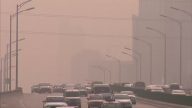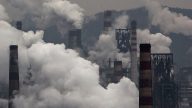【新唐人2013年04月01日讯】美国《彭博社》3月28号刊登《空气污染、出生缺陷和中国的危机》一文。文章提到:北京大学健康科学中心及美国德州大学奥斯汀分校的研究伙伴,最近公布了一份对山西省严重新生儿出生缺陷的10年调查结果。研究团队调查的是“先天性神经管缺陷”的发生频率,他们在调查中看到了令人震惊的事实。
煤矿丰富的山西省,是中国污染最严重的地区之一,研究人员在10年的时间里,收集了80个死胎或有缺陷新生儿的胎盘。他们的分析证实,这些婴儿在子宫内被暴露于显着浓度的农药、工业溶剂,特别是多环芳香族碳氢化合物(PAH),这些都是化石燃料燃烧时释放到空气中的物质。研究人员发现,在有缺陷的婴儿胎盘中,有较正常婴儿胎盘更高浓度的化学品。
母亲被暴露的环境与孩子的出生结果有明显关联。
在美国,每1万名活产婴儿中,有7.5名婴儿有神经管缺陷。但在山西,这一数字是美国的18倍,也就是:每1万名活产婴儿中,有140名婴儿存在神经管缺陷。
美国专业学术月刊《环境健康展望》杂志,2008年10月发表的另一项研究发现,在重庆市关闭一个燃煤电厂后,两组孕妇出现了明显变化。
研究人员分别在2002年和2005年,招募了两组不吸烟的母亲和新生儿。所有这些妇女都居住在重庆市铜梁电厂2公里以内。而电厂于2004年关闭。在这些孕妇生产时,研究人员采集了脐带血,分析记录了汞和铅的存在情况。
研究人员追踪这些孩子到他们的第二个生日,以评估他们的行为和智力发育。研究发现,2002年出生的孩子,由于当时电厂仍然运行,平均表现发育迟缓,尤其是运动技能的迟缓表现更突出。但出生于2005年的孩子们没有表现出同样的问题。参与研究的人员(佩雷拉)说:“这实际上是一个很好的yabo88官网故事,政府关闭了电厂,你可以看到立竿见影的改善。”
湖北作家阮云华表示,这个现象不是一两年造成的。这是长期的政府工作不到位,以及政府渎职所造成。
湖北作家阮云华:“为了GDP不顾老百姓的生活。所以导致现在出现很多新生儿畸形发育和怀孕,都造成很大的影响。实际上已经构成了一种犯罪了。政府不作为,就导致了对老百姓生命的轻视。像我们家乡也出现过计划生育导致人命案的问题,也是一样的。他们只考虑完成指标,而不考虑到老百姓的生命安全以及生活质量。”
据大陆卫生部发布的《中国妇幼卫生事业发展报告2011年》显示,根据全中国医院监测数据,中国“出生缺陷发生率”呈上升趋势,由1996年的87万7千名,上升到2010年的149万9千名,增幅达70.9%。2010年,医院监测的“前五位出生缺陷种类”是:先天性心脏病32万7千名、多指(趾)16万4千名、总唇裂12万8千名、先天性脑积水6万、神经管缺陷5万7名。共占全部出生缺陷的49.1%。
而《广州日报》1月4号报导,中国是新生儿出生缺陷的高发国家之一。2006年的《中国儿童发展报告》显示,中国每年约有20万∼30万肉眼可见的先天畸形儿出生,加上出生后数月和数年才显现出来的缺陷,缺陷儿总数高达80万∼ 120万。
今年3月号的《环境与健康展望》杂志,刊登有关城市空气污染和分娩结局的研究,发现空气污染与出生缺陷有关联。这项研究调查分析了9个国家的300万个出生记录,发现PM10和PM2.5的空气悬浮颗粒浓度高都会区,导致低出生体重婴儿的比例增加。比如每立方米的PM10浓度每增加10毫克,低体重出生婴儿的比例就会增加3%。报导说,这项研究中并没有纳入中国的例子,而中国是PM污染最严重的国家之一。
采访编辑/秦雪 后制/萧宇
China’s Birth Defects Linked to Air Pollution, Research Shows
On Mar 28, Bloomberg published an article titled,
“Air Pollution, Birth Defects and the Risk in China.”
The article cited a research by a Princeton Global Scholar
and his partners at Peking University Health Science Center and the University of Texas, Austin.
They recently published results of a 10-year investigation
on severe birth defects in Shanxi Province, China.
Investigating the alarming frequency of congenital neural
tube defects, the researchers found astonishing results.
The coal-rich Shanxi province is one of the most polluted
regions in China.
Over 10-years, the researchers gathered placentas from
80 stillborn or born with a disorder infants in Shanxi.
Based on their analyses, they confirmed that those infants
had been exposed in utero to significant levels of pesticides,
industrial solvents, and especially PAHs (polycyclic aromatic
hydrocarbons), released in the air when burning fossil fuels.
As a result, the placentas of infants with birth defects
was found to have higher concentrations of the chemicals than that of the other infants.
The environment which pregnant women were expose to
was found to have significant correlation with the health of their infants.
In the U.S., for every 10,000 live births,
there are 7.5 infants with neural tube defects.
In contrast, in Shanxi this number is 18 times higher,
with 140 per every 10,000 infants being with birth defects.
In October 2008, another study with similar significance
was published in the US-based academic journal “Environmental Health Perspectives”.
The authors found notable difference between two groups
of women in Chongqing City, who had babies before and after the closing of a power plant nearby.
The researchers enrolled two groups of nonsmoking
mothers and their newborns in 2002 and 2005.
All the women lived within 2 kilometers of the site of
Chongqing’s Tongliang power plant, closed in 2004.
Samples of umbilical cord blood were collected at the time
of delivery and analyzed to record the presence of PAHs, mercury, and lead.
The children were observed by the researchers until their
second birthday to assess their behavioral and intellectual development.
They found that the children born in 2002, when the power
plant was still operating, showed on average developmental delays, especially in motor skills.
Those born in 2005 did not exhibit the same setbacks.
Perera, one of the researchers said,
“It’s actually a good-news story.
The government shut down the power plant, and you could
see immediate improvements (in child and maternal health).”
Ruan Yunhua, a Hubei writer remarked,
the health of babies is not a short-term issue.
The current situation results from inadequate government
efforts and its malfeasance over a long period.
Ruan Yunhua, Hubei writer: ”To pursue GDP growth,
the (Chinese Communist Party / CCP) government has ignored people’s livelihood.
Therefore right now there are so many babies
born with defects, which greatly impacts our lives.
This is already a crime. The inaction of the government
is equivalent to holding the ordinary people’s lives cheap.
In my hometown there were also mothers killed
due to forced birth control so we see the same problem.
They (the CCP authorities) only think of accomplishing
their goals, while caring little about people’s life, safety, and quality of livelihood.”
The Report on Women and Children’s Health Development
in China (2011), published by China’s Ministry of Health,
showed an increasing trend in the rate of birth defects,
according to statistics collected from hospitals nationwide.
The babies with defects totaled 877,000 in 1996.
This number increased by 70.9% to 1,499,000 in 2010.
In that year, the five most frequent birth defects were:
congenital heart disease (327,000), polydactyl (164,000),
cleft lip (128,000), congenital hydrocephalus (60,000),
and neural tube defects (57,000).
These account for 49.1% of all the birth defects.
A report of Guangzhou Daily newspaper on Jan 4 revealed,
China is a country with high rate of birth defects.
The 2006’s National Report of Child Development in China
shows that each year there are around 250,000 babies with congenital problems born in China.
Further counting the babies whose defects appear several
months or years after birth, the total number of babies with health issues can reach 1.2 million.
The Environmental Health Perspectives’ journal published
a study this March, about the effect of urban air pollution on birth outcomes.
The study found a correlation between the air pollution
and the health defects in babies.
The researchers examined 3 million birth records
in nine countries.
They found a correlation between low birth weight
and high levels of PM 10 and PM 2.5.
For instance, each 10 micrograms increase of PM10
per cubic meter was found to correlate with a 3 percent increase in the number of babies with low birth weight.
However, this study did not include China, where the levels
of air pollution are generally higher than those in the nine countries studied.































